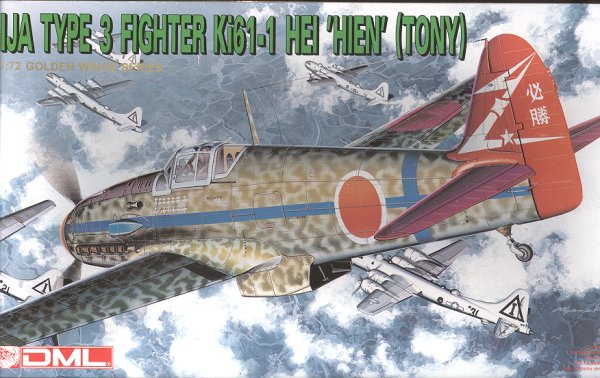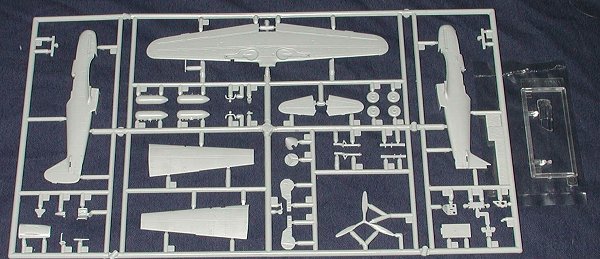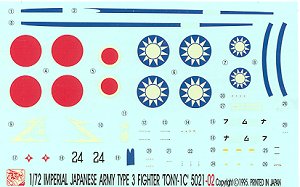
|
KIT: |
Dragon 1/72 Ki-61 'Tony' |
|
KIT # |
5021 |
|
PRICE: |
$24.99 (that's what it said on the box) |
|
DECALS: |
Two Aircraft |
|
REVIEWER: |
|
|
NOTES: |

|
HISTORY |
The Japanese were not really good at building water-cooled engines. In fact, they didn't really like them. The addition of the coolant system was just one more thing that they had to worry about. Besides, their air-cooled radial engines were more than sufficient for the aircraft that they had and none of their enemies had anything that could best them anyway.
However, as WW opened in Europe, the Japanese saw that most of the fighters that were on the 'winning' side were powered by liquid-cooled engines. These seemed to produce the kinds of horsepower that Japan's radials were not able to match. Efforts were made to license produce the Daimler-Benz DB-601 engine. This was successfully done and in Feb 1940, Kawasaki was directed to design an airframe around this engine.
This produced the Ki-60, a fighter that sacrificed speed, rate of climb and cannon armament at the expense of range and maneuverability. It showed promise, but was not successful as it was not liked by the Japanese pilots and suffered from overweight. Though the weight problems were reduced, it was decided that a cleaner airframe was needed and this produced the Ki-61, an aircraft that was lighter and therefore, faster.
The Japanese DB.601 was called the Ha.40 and modified somewhat to meet Japanese needs of production. Unlike the Ki-60, the heavy cannon were replaced by 12.7mm machine guns in the wings and similar or lighter guns in the upper cowl. Later variants of the Ki-61 reverted to cannon in the wings. Flight testing started in December of 1941 and the prototype met or exceeded all expectations.
The first production aircraft left the factory in August of 1942 and was test flown against a Bf-109E, P-40E, Ki-43 and Ki-44, which it easily bested. In April of 1943, the first combat units, the 68th and 78th Sentais were sent to New Guinea. Thanks to the armor plating and self-sealing fuel tanks, the Ki-61 did well against Allied aircraft. It was a pig on the ground due to engine overheating problems, but once in the air, it was a joy to fly and greatly liked by its pilots.
Not the same could be said of the plane by its ground crews. Maintenance was a constant headache and poor accessibility of components as well as a basically non-existent supply chain for parts meant that a lot of Ki-61s were cannibalized to keep others in the air. Later in the war, a lack of available engines meant that many airframes were languishing in storage yards. This was cured by the installation of a high horsepower radial engine developed for bombers, and the Ki-100, thought by many to be one of the finest Japanese fighters of the war, was born. But that is another story.
|
THE KIT |

Like so many early Dragon kits, this one is molded in a light grey plastic with a slightly pebbly texture. There is no flash, but thanks to thick components on the interior sidewalls, there are sink marks around the cockpit. I could find no ejector pin marks on any of the parts.
The sprue attachment points are a bit larger than one would expect from a
'standard' injection molded kit, but not excessive. All of the parts are on one
tree and there are few options. What options there are consist of regular or
weighted tires, raised or lowered landing gear and drop tanks. The canopy is a
single piece and a bit thick, making it
 difficult to see any cockpit
detail. Too bad, as the cockpit is fairly well detailed. There is good detail on
the cockpit walls as well.
difficult to see any cockpit
detail. Too bad, as the cockpit is fairly well detailed. There is good detail on
the cockpit walls as well.
Instructions are quite good and very reminiscent of current Hasegawa kits with its multi colored construction steps and Gunze paint references. The decals for this 1995 kit are the box art aircraft, a very famous and colorful plane flown by Lt. Teruhiko Kobayashi in 1945 and a captured, post war aircraft flown by the 6th F/BG of the Chinese Air Force in Beijing circa 1945. Both aircraft are overall natural metal with dark green mottling on all upper surfaces and the fuselage side. Decals look typically Japanese in that they are a bit thick, but appear to be well printed.
|
CONCLUSIONS |
Well, I'm not that much up on 1/72 Ki-61 kits, but would think that, at least in the box, this is an improvement over the much older Hasegawa kit. It appears quite reminiscent of the Fine Molds Ki-100, though I doubt if there is any direct connection.
If you would like your product reviewed fairly and quickly by a site that has well over 150,000 visitors a month, please contact me or see other details in the Note to Contributors.